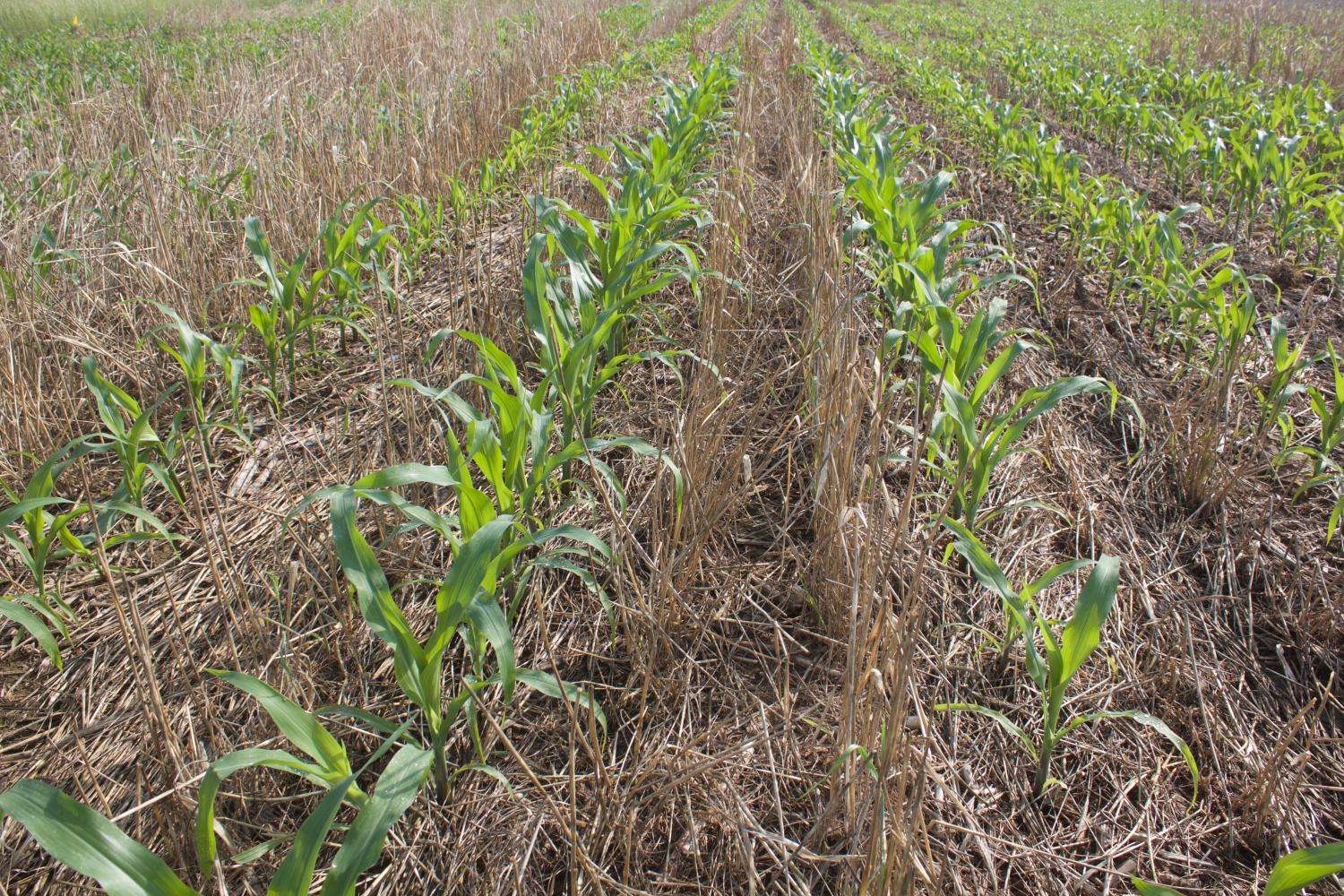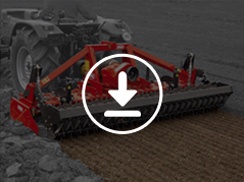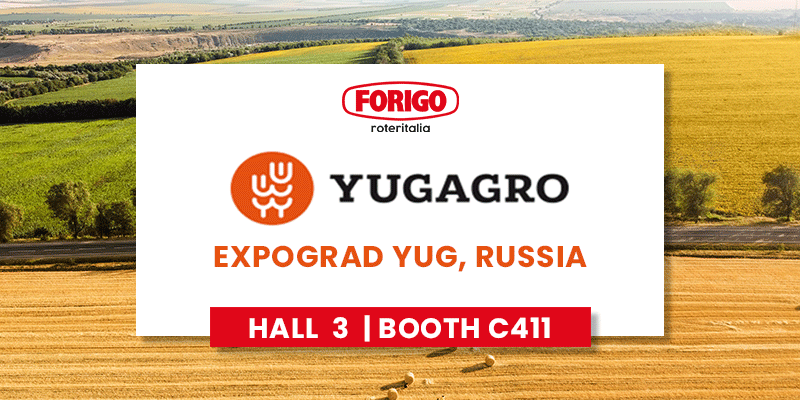Cover crops. What does it mean? A lot of people talk about this typology of crops and many suggest its utilization. But, in particular, what are they? What kind of benefits could they provide to a farm? One of our Forigo experts will explain this to you.
Enjoy your reading!
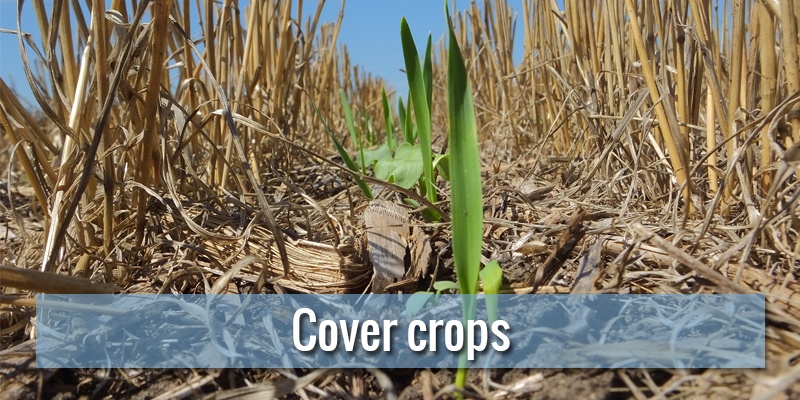
What does it happen when, between a crop and the next one, is kept bare soil?
As first instance, the occasion to convert solar energy into organic matter is wasted. In this way the trophic net present in the soil and on its surface is not fed, with consequence loss of biodiversity. Furthermore, by leaving the soil bare as it is, when it rains the soluble nutrients are leached and soil erosion (by rain or wind) happens; both those phenomes reduce soil fertility.
When the soil is left resting after a previous tillage or even plowed, those negative effects are amplified. Moreover, other negative aspects appear, such as the ones provoked by excessive soil oxygenation, caused by exposition of the soil to the air; this leads to a fast breakdown of organic matter. It is clear now that leaving bare soil without vegetation is a waste of resources.
A first step towards a more correct management of the agricultural field is to keep uncultivated soil (or just worked on the surface) covered by vegetable residues of the previous crop. In this way some of the bad effects described above and erosion phenomes are tackled with discrete efficacy. The optimal condition is achievable only with the constant presence of live vegetable cover: which can be a second harvest or a cover crop.
Cover crops, literally “covering crops”, are also called catch crops, according to farmer’s idea of protection of the soil from erosion or to avoid nutrients loss by leaching. Actually, both actions are linked to each other; following a particular way, also the other one will be followed in some extent.
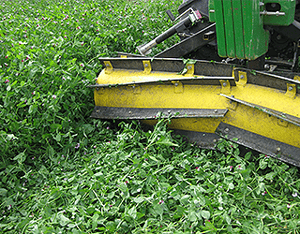 A cover crop is also defined “manure crop”, that is a crop which is destined to be buried and not intended for a production. At the end of its cycle, the cover crop is not always interred and for this reason the word “manure” is not completely right.
A cover crop is also defined “manure crop”, that is a crop which is destined to be buried and not intended for a production. At the end of its cycle, the cover crop is not always interred and for this reason the word “manure” is not completely right.
In fact, the vegetation can be chemically dried out and then mechanically shredded or simply shredded by common strawchoppers or by a crimper roller.
“Covering crops” allow, in a period of non-cultivation, to intercept the solar radiation and to catch the nutrients improving the ecosystem efficiency: an efficient ecosystem asks less inputs to produce, reducing cultivation costs. The introduction of this crop in the productive cycle, helps to improve the sustainability of the production process, that’s because it allows to utilize ecosystem potential in favor of the production.
These motives led a lot of regions to insert the manure crops (for farms practicing conventional field management) or the cover crops (for conservative agriculture) among the prescriptions of agri-environmental measures. Covering crops can also help to comply with greening obligations.
It’s worth to remember that the positive actions produced by the covering crops, are also played in some parts by interlayer crops, so with productive aims.
Cover crops: how is it done?
Cover crops may be cultivated using the residue fertility of the previous crop, or by anticipating fertilization and soil preparation jobs destined to the main cultivation; in this way, both crop can get benefit.
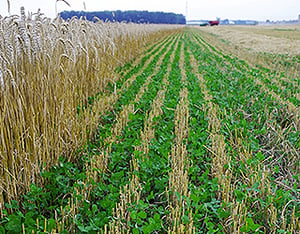 Normally, are utilized cool season grasses in winter period, as waiting for a summer cycle seeding, and warm season grasses in summer period, as waiting for winter cycle seeding.
Normally, are utilized cool season grasses in winter period, as waiting for a summer cycle seeding, and warm season grasses in summer period, as waiting for winter cycle seeding.
Summer seeding should be done by seed drills equipped/composed by passive working organs for a gentle processing, or by specific hard pan seed drills because there’s the necessity to cover the seed in the proper way and let it stay in contact with the residual humidity of the soil.
It can be helpful making a soft summer stubbles processing with aim to preserve hydric resources of the soil, interrupting capillarity upwelling; favor residue degradation, shuffling it within the soil; clean out the soil surface from weeds.
In some cases, may be interesting to apply the old “beds” technique: on winter cereal, before harvesting, a clover is planted which will take root, protected by the crop, and after the crop harvest will continue to vegetate, making a good covering crop action.
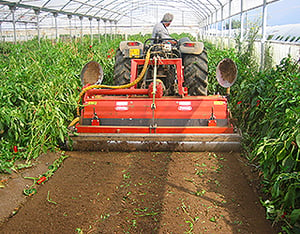 Centrifugal fertilizer, which is capable of great prompt effectiveness and doesn’t affect too much cultural costs, it is applicable to autumn seeding only, of only one species, with particular big seeds, on pre-worked soil (even only on surface) and foreseeing, according to soil characteristics, a following rolling to force seed adherence with the soil.
Centrifugal fertilizer, which is capable of great prompt effectiveness and doesn’t affect too much cultural costs, it is applicable to autumn seeding only, of only one species, with particular big seeds, on pre-worked soil (even only on surface) and foreseeing, according to soil characteristics, a following rolling to force seed adherence with the soil.
Two weeks before main crop seeding, cover crop must be mechanically, chemically or both, deleted. The burial must always be superficial, otherwise, great part of the job would be wasted. The stone burier machine can be the ideal solution in the horticultural field, where residual let on the on the surface may obstacle seeding or transplanting processes.
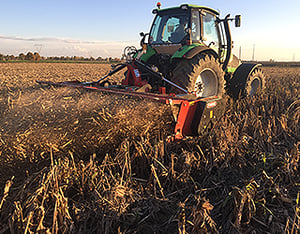 In extensive crops, actually, a soil preparation without burying is surely the best option. Shredding can be helpful mainly for high vegetation: with crimper roller, a smooth roller fitted with blades, for dry soil (with humid soil, the roller begins to being stuck by the soil, making it no longer effective); or with implements operated by PTO, it is a more expensive solution, but permits to avoid chemical weeding, especially on very dense cover crops.
In extensive crops, actually, a soil preparation without burying is surely the best option. Shredding can be helpful mainly for high vegetation: with crimper roller, a smooth roller fitted with blades, for dry soil (with humid soil, the roller begins to being stuck by the soil, making it no longer effective); or with implements operated by PTO, it is a more expensive solution, but permits to avoid chemical weeding, especially on very dense cover crops.
Foreseeing a conservative field management, it is suggested to equip the straw chopper with a dispatcher, so that chopped vegetation is distributed above the entire surface. The following sowing of the main crop can be done on non-worked soil after a rapid pass with a disks harrow, capable of mixing the organic residue within the first 4-5 soil cms.
The species has to be selected according to the season and to the provided preference action.
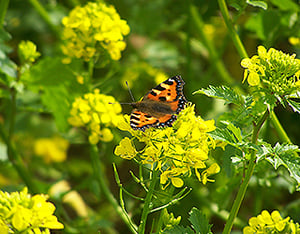 Poaceae (or grass) have the capacity to intercept nitrogen compounds; they are composed by a superficial root net, usually very extended, with a good anti-erosion capacity.
Poaceae (or grass) have the capacity to intercept nitrogen compounds; they are composed by a superficial root net, usually very extended, with a good anti-erosion capacity.
Leguminous plants augment the level of azote in the soil, supply organic substance which decomposes faster, thanks to the higher level of azote in the terrain. However, they are less effective in catching the nitrates in the soil. Their root net, taproot, works pretty well the soil even in depth.
For this reason they are often used in the soil’s conservative management. Brassicaceae plants may help to limit the development of nematodes (and other pathogen elements) because, during their decomposition, release isothiocyanate. In this case, if we want to maximize the biocidal action, it’s necessary to bury (superficially) the whole plant (15-20cm), as per green manure chart.
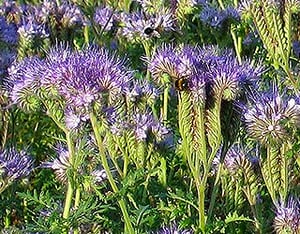 Among the other species we recall the Phacelia, which is part of Boraginaceae family, largely used for its fast growth, catching action and because is a mellifera plant, great producer of nectar, which is a common characteristic for leguminous plants.
Among the other species we recall the Phacelia, which is part of Boraginaceae family, largely used for its fast growth, catching action and because is a mellifera plant, great producer of nectar, which is a common characteristic for leguminous plants.
Characteristics similar to Phacelia’s are shared by the buckwheat, which is part of Polygonaceae family.
It is also convenient the use of mixtures, since it allows to mediate between the different species’ actions, In this case though, is not easy to set the seed drills or the machines used for seeding purposes.
This chart summarizes the most important characteristics for most common cover crops (seeding times are indicative and vary from North to South: A, autumn; W, winter; S, springtime; SU, summer):
|
Species |
Botanical family |
Seeding time |
Organic substance |
Erosion control |
Weeds control |
Nitrate capture |
Melliferous attitude |
Other actions |
|
Wheat, Barley, Oat, Rye |
Graminaceae (Poaceae) |
A |
*** |
*** |
*** |
*** |
- |
- |
|
Italian rye-grass (Lolium multiflorum) |
A, W |
*** |
*** |
*** |
*** |
- |
- |
|
|
Sudanese sorghum |
S |
*** |
*** |
*** |
*** |
- |
- |
|
|
Switch grass, Mile |
S, SU |
*** |
*** |
*** |
*** |
- |
- |
|
|
Phacelia (Phacelia tanacetifolia) |
Boraginaceae |
S, SU |
** |
* |
** |
* |
*** |
- |
|
Common vetch (Vicia sativa) |
Leguminous plants (Fabaceae) |
S |
** |
* |
*** |
- |
** |
Nitrogen fixation |
|
Hairy vetch (Vicia villosa) |
A, S |
** |
* |
** |
- |
** |
||
|
Lucerne (Medicago sativa) |
A, S |
*** |
*** |
*** |
- |
** |
||
|
Beans |
W, S |
** |
* |
** |
- |
** |
||
|
Purple clover, White clover |
A, S |
** |
** |
*** |
- |
*** |
||
|
Embodied clover (Trif. incarnatum) |
A |
** |
* |
** |
- |
** |
||
|
Mustard (Sinapis alba) |
Brassicaceae (Cruciferous) |
S |
** |
* |
*** |
** |
* |
biocide |
|
Radish (Raphanus sativus) |
S |
** |
* |
** |
** |
* |
||
|
Rapeseed (Brassica napus) |
A |
** |
* |
*** |
** |
* |
- |
|
|
Buckwheat (Polygonum fagopyrum) |
Polygonaceae |
S, SU |
** |
* |
*** |
* |
** |
- |
The benefits manifest themselves only if cover crops form a good volume, in other words when sprouting, development and growth can satisfy the normal standards and are enough homogeneous. In fact, even though the product is not meant to be sold, the effects provided by the cover crops can be economically judged and compared to their cost and management.
We don’t have to ignore the fact that these crops cost work, management and corporate effort, use of machinery, seedlings and other technical resources.
Cover crops: Erosion-contrasting action
Bare soil is victim of the erosion caused by water and wind: if they do not find any obstacle during their route, they can easily remove and transport the soil’s particles. This phenomenon, mostly visible in presence of slopes (it’s present also on flat lands) where the transport is mostly done by the water which follows the inclination of the fields for the drainage. For example, in case of heavy rains and cultivations on beds reaching nearly the 2% of slope, removal of 10t/ha of soil have been recorded. A part of this soil, which do not reach the farm drainage net, reaches, through the main drainage net, the sea.
The presence of cover crops stops or reduce the erosion through two main actions. The first, detention action, depends on roots development/growth; the second action, the absorption of wind and water kinetics, depends on the development of the above-ground part.
Cover crops: Catching action
Nutrients captured by the roots, in particular nitrate, are immobilized by the vegetable biomass and stolen from the leaching.
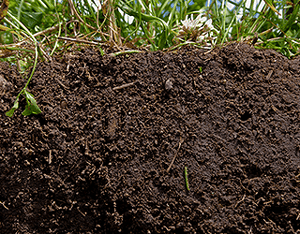 In the soil, the biological activity, which is not interrupted by a crop, proceeds thanks to both the organic substance (for example last crop residues) and the humus already present in the soil, through complex biochemical processes, among whom the mineralization. Mineralization releases the nutrients which, in case of low presence of plants, can be easily leached (nitrogen composts) or transported outside the eroded part of the field.
In the soil, the biological activity, which is not interrupted by a crop, proceeds thanks to both the organic substance (for example last crop residues) and the humus already present in the soil, through complex biochemical processes, among whom the mineralization. Mineralization releases the nutrients which, in case of low presence of plants, can be easily leached (nitrogen composts) or transported outside the eroded part of the field.
The biological activity is present also at low temperature (few degrees above zero are enough) or in low humidity conditions. In general, we can assume that the environmental conditions which allow the underground microorganisms’ activity are the same (most of) as allow the plants growth.
When mineralization processes are happening in the soil, the surrounding vegetation can intercept the products of these activities and use them to create new biomass.
Cover crops: influence on organic substance
Cover crops bring organic substance, preventing its impoverishment. This provokes an improvement of soil fertility, which can be attributed to the stimulation if microbiological activity and humus increment in the soil.
Humus presents very high capacity of cation exchange, superior to clay best variety’s. Furthermore, cover crops can absorb nutrients concentrating them into the specific zone of the field, mostly explored by the main crop.
In this chart, there’s an esteem of the quantity of organic substance that a cover crop can supply with a production of 3t/ha of vegetable mass.
|
Parameters |
Valor |
|
Roots residue t/ha |
2,40 |
|
Humus quantity , roots net |
0,20 |
|
Epigeal apparatus residue, t/ha |
3,00 |
|
Humus quantity, epigeal net |
0,15 |
|
Addition of humic organic substance, t/ha |
0,930 |
|
Addition of humic organic carbon, t/ha |
0,539 |
Cover crops: biodiversity action
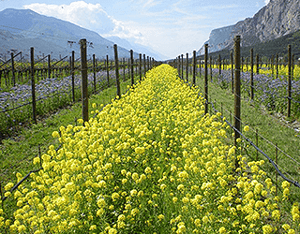 The use of cover crops contributes to the elimination of crops parasites (for example nematods, through biocide plants), helps with feeding integration for breedings (bees, with melliferous plants or herbivores with species indicated for grazing), facilitates the development of useful wildlife (with species able to host and feed syrphidae and good beetles), favour the presence of conditions required for homeostasis or, more in general , for the increment of biodiversity.
The use of cover crops contributes to the elimination of crops parasites (for example nematods, through biocide plants), helps with feeding integration for breedings (bees, with melliferous plants or herbivores with species indicated for grazing), facilitates the development of useful wildlife (with species able to host and feed syrphidae and good beetles), favour the presence of conditions required for homeostasis or, more in general , for the increment of biodiversity.
Furthermore, in orchards and vineyards, in which pollinating insects are needed for setting the fruits production, it is possible to cultivate Phacelia, Brassicaceae, leguminous species between the rows, in other words, suppliers of nectar.
Cover crops: anti-weeds action
We don’t have to overlook, especially bio farms or for whom are involved in integrated pest control, also to the pest control function of cover crops, normally based on competition. In fact, cover crops grow quickly and aggressively, in this way they can intercept the sun rays and compete with weeds for water and nutrients.
Some species, like for instance Rye, also produce allelopathic substances which contribute to reduce weeds’ presence also during the following weeks from their devitalization. These substances may act as obstacle to the growth of the roots and to weeds germination as well.
Experts haven’t defined yet the precise technique: the first indications highlight that the anti-germination capacity of the cover crops, has more efficacy when cover crops are not buried or at least mixed with the soil just few centimeters. In addition, they are more effective on species with small seeds and the duration of the effect continues up to three-four weeks after their devitalization.
Conclusion
In this article we analyzed in depth what are cover crops and how they can be introduced in the production cycle of the farm.
We also took knowledge of the various benefits they can bring to whom decides to go on with such technique: from anti-erosion action to the development of bio-diversity which can provide positive effects, starting from the soil surface up to more centimeters deep.
We hope we gave you all the information you were looking for. If you need further indications or guidelines for choosing the right machine for this type of work, please do not hesitate to contact us! Our experts Forigo will be glad to answer to your questions.




